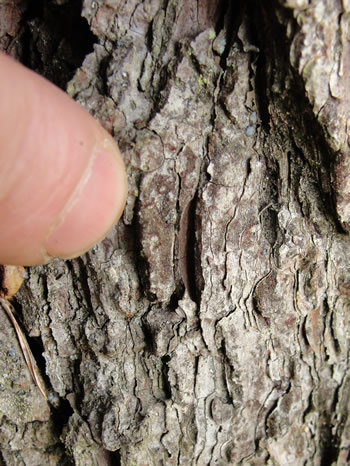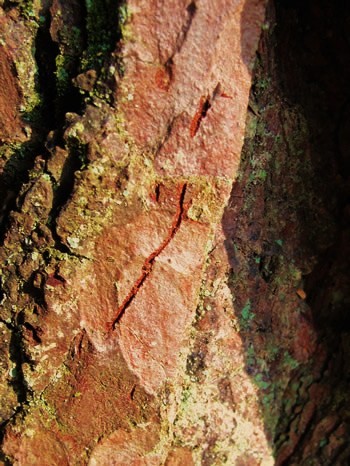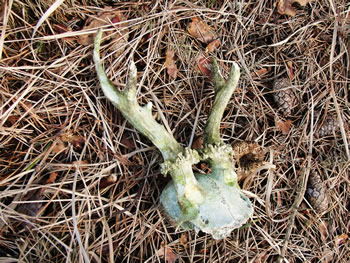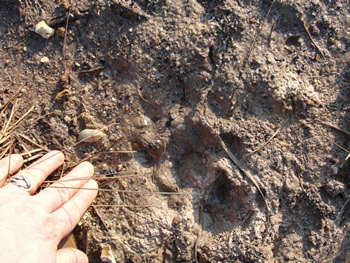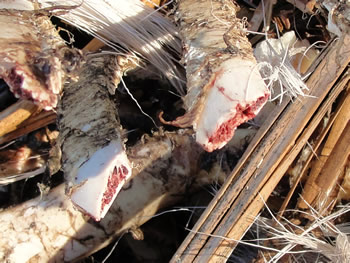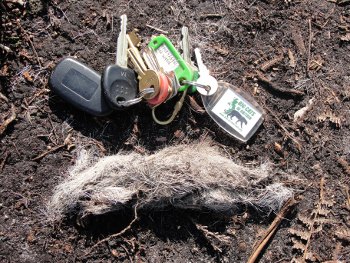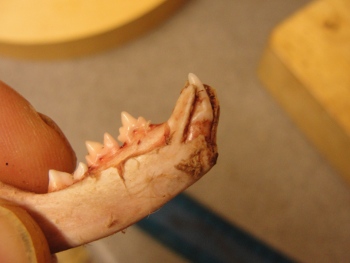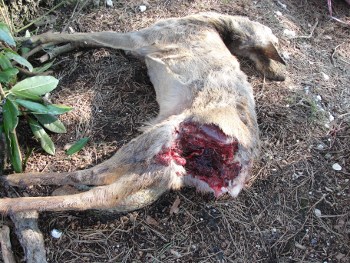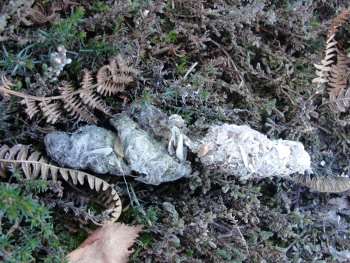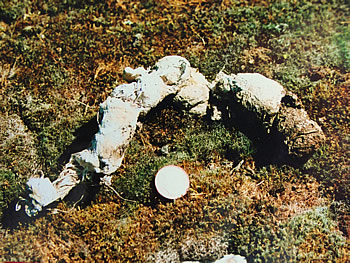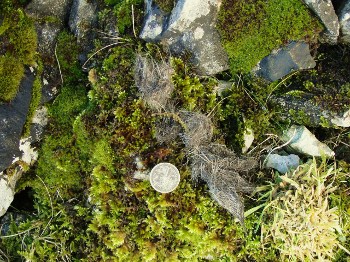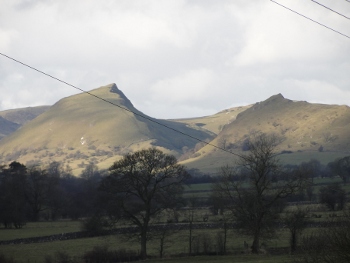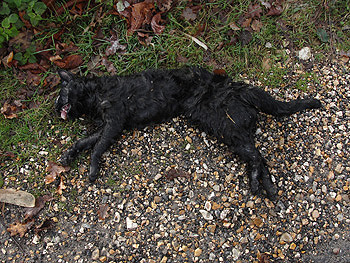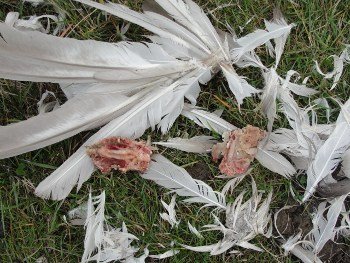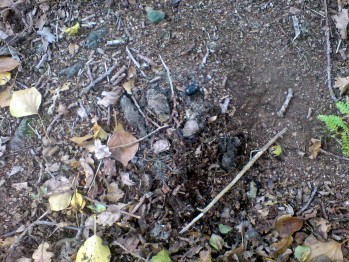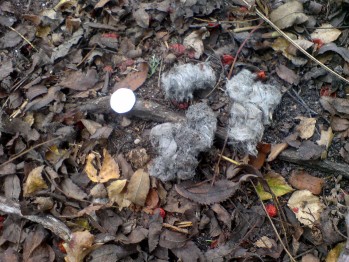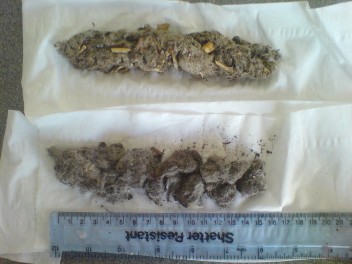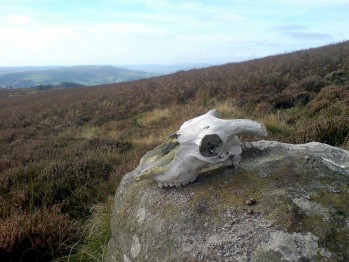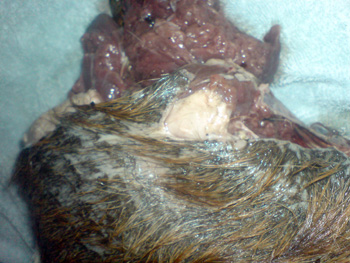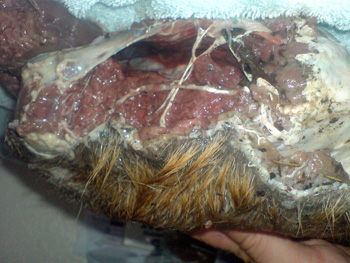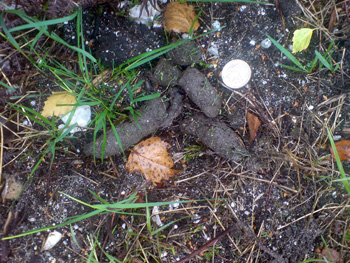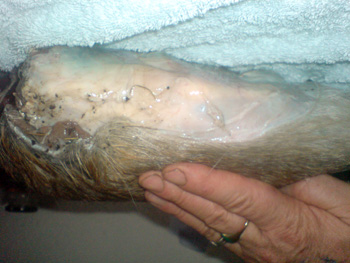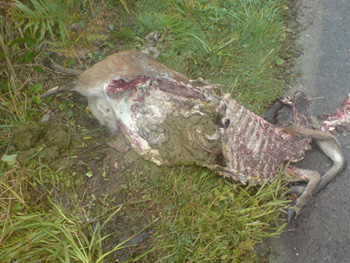One of the most challenging aspects of the large cat subject has been whether or not the animals in question are true types, hybrids or unknown species. some people think that they may be evolved types particular to the UK. Well, evolution is always at work, and all animals and plants are adapting themselves to survive, and that includes any mammals that are in the wrong place at any given time. But, what is the wrong place? that is surely a human concept as we think that something is either right or wrong and we tend to judge others albeit human or animal.There can be no wrong in the large scheme of things in relation to wildlife at least, as everything sorts itself out in the long run. We humans only look into the short term aspects of out fleeting lives in a planet that has lived for billions of years, had many mass extinctions, continent misplacement, disruption of all kinds resulting in animal and plant species movements across the entire world. There is one easy way of looking at this; all animals and plants are native to earth regardless of what country they come from, just like people. I am not suggesting that we should allow all kinds of living organisms to flourish wherever they like or where humans want them to be, but where the damage has already been done I do believe that things should be left as they are and perhaps better prevention in future of none native animals or plants invading other lands if damage may well persist. Ecologists have been too keen to point to none natives and falsely claim that damage is being done. Many none natives play vital roles in the equilibrium of the food chain and if some species were to be taken out, then all hell would break lose and we would lose certain species that are native, but depend on none natives for food and recolonization of former habitats were they were once exterminated. Rabbits ,rats and grey squirrels are prime examples.There are many species that have caused much damage to environments of course. Pumas and leopards are not native and people would no doubt be quick to point fingers and accuse. Leopards were once native to the UK, when we were joined to Europe and there is actually no natural reason as to why they went.Pumas in their modern form have not lived in Europe. Cats are cats, and most of them are not specialists and are very adaptable and change to suit their environment.A leopard or puma would not be out of place in the UK as they would not target a certain species for food or to over hunt a species to extinction.It is worth remembering that the natural range of the common leopard is the whole of the old world except Australasia. The natural range of the puma is the whole of the American continent. We could of had it on the other side of the Atlantic but that did not happen after the break up .The jaguar evolved into its type later on and survives today in the south America and some southerly North American states.The cats either adapt or die out.so far, both cats have survived and adapted and do what they do best and that is to eat a variety of prey especially deer, with some smaller carnivores alongside.Such a development is healthy within the natural cycles of life and vital .The UK has been without apex predators for such a long time that the balance had got out of hand hence the huge numbers of deer, foxes, badgers, rabbits etc.Now things can change for the better as the apex predator takes control,that is if the animals are allowed to do so by humans.Intervention could cause chaos if authorities were to work on the notion that these animals are detrimental to the environment. Having both puma and leopard is one thing but what if these animals have managed to interbreed and create a hybrid ? firstly, I know that many zoologists would naturally scorn at such ideas and given their general knowledge of such then that is understandable, but things can change especially if humans have interacted in an unnatural way. We have never been confronted with a situation of two similar species of large cats that have not lived on the same continent co existing in a smallish area before, so have never reaped results.One can assume, but in reality, nature knows best and works in ways in which we humans are often surprised. Cats can interbreed and in captivity many hybrids have been created.In the wild they do not usually as they started off together then went their own different paths creating new species when and where applicable, that is how evolution works. When a certain situation arises such as too few of a certain species or two separate species co existing, then the species may try to merge back , almost like a devolution. Desperate animals can create change and maybe that has happened in the near past when there had not been too many of each species in question. I do believe that there are genuine puma and leopard in the UK as well as lynx.The animals I have seen mostly fit the typical cat types to look at, but recently, over the last ten years or so there seems to be so much anecdotal evidence to suggest that cat species are hybridizing.I do believe that leopards and puma have been doing so.The behavior of animals seen by people seem to fit both species.The black, brown, spotted or striped cats seem to act more like pumas in respect to sounds,and movement, but like leopards in respect to hiding prey.I look at much hair collected mainly by myself but also other people from different parts of the UK and I am finding interesting results from my analysis. I look at the hair in a very basic way under the microscope and look at the medulla within the hair and the outer scaling.Leopards are different to puma or lynx generally but I am finding more hair that does not look like any particular species but as if a combination of two species, such as leopard and puma.Black hair that one would assume to be melanistic leopard has the medulla of a puma ! Also their seems to be giant domestic cats out there also! I do not know if there are puma and domestic cat hybrids but I think that it is very possible. So we have a dilemma on our hands:that not only do we definitely have leopard, puma and lynx living wild and breeding but we have all kinds of hybrid cats !This must cause a real head ache to all that are serious about biologically assessing what species we have.Then people will need to decide whether or not we want hybrid animals if indeed we want large cats of any kind in the UK. Again, left to nature things will settle down in time, I casually say. If we were to disappear and return a few thousand years from now, we may find an unknown species of large cat in UK unlike any we previously knew before. That species would have evolved from a mix of hybrids and recreated its own, or two species. That is how things happen. Humans on the other hand would want to intervene as usual and take control. I do not believe that authorities would want to leave things to settle down and let nature take its own route. I think that intervention of a lethal kind will prevail. Sooner or later a government department will meet and decide what to do,how to spend money on eradicating, how to tell the public, how to incorporate large cats into the teaching of environmental science, schools, farming, veterinary science, etc.One thing is for sure, given the current financial situation we are in , I cannot see any forthcoming proper eradication programme being successful, even if it were in place and had been for years.The animals are many and if we humans survive this century then many people are going to have to pick up the pieces.I personally do not see the cats as being a big problem at the moment, and I will reserve judgement on possible future problems or challenges.
The current view on the issue
The issue at the present time is complex with many formed groups, websites, people in on it from all angles.There are researchers all across the UK doing their bits with varying amounts of both knowledge and commitment. There is also a lot of jealousy among groups and especially individuals in regards to knowledge and evidence.This has led many folk to shy away from groups and do it alone.there are so many so called experts on the case who are actually far from expert in this field.There are armchair experts that have no knowledge of natural history who think that they are the best !There is so much disagreement within the subject that it could cause a war, with so many idiots jumping on board and writing rubbish on blogs etc.Even among good groups there is so much that many people just do not understand.What is more debatable at the moment is not how to prove that large cats exist in the UK, but how to deliver the message to the general public who have not been given the truth by the authorities.The authorities know all about these animals. They chose to hide the truth and for some good reasons although I personally am not one of these nanny state people who do not like upsetting the apple cart. Truth should be told at all costs as the repercussions of hidden truths backfire tenfold.The government has a moral obligation to reveal the truth in the right way, without causing panic, or accusations or claims for lost livestock.It can be done in such a way as not to cause too much of a problem. Causing disrespect to people who have researched this subject for years is no good, and damaging to their reputations and life in general. It is no real big deal, we are only talking large cats here, not planet invading aliens !and yes there is a very small potential for large cats to eat people sometimes, but domestic dogs kill people every year and nothing is done about the escalating problem of dog keeping.We must put things into perspective here and make sure that the uneducated portion of the public do not panic and accuse.What heightens the problem is the media with the sensational headlines of `Deer ripped apart’ or` cow had its throat torn out by big cat ‘etc etc.These kind of stories only fuel the public ignorance and must be stopped.People are gullible and we know all too well how witch hunts start !
The sign of the claw
I visited a new area of Purbeck, an area where I rarely go and indeed have not investigated then area fully. On doing so I came across a good area for leopard to hunt and lie up in dense woodland and heath well away from the beaten track. Many large old Scots pines grow here and as usual are great for searching for marks of leopards that shin up them.Here are some of the claw marks that can be found, from the deeper gouge cut,
to the scrape claw mark
such as this.There are several other animals that regularly scratch the bark of tree trunks ,deer mark the lower areas, squirrels and woodpeckers mark anywhere but have similar sized claws and do not make many long scratches but more plucking, like nicks.When a cats claws are blunt, they cut a squared of furrow just like this.Also at the top of the pic, one can see where an old scratch occurred mirror imaging the fresher one. leopard likes to use the same route up the tree and often places its feet , thus its claws in the same place.Underneath the trees were the remains of roe and sika deer, such as this young roe, with a third tine on its right antler, they had been eaten down by rodents.
Near by was a nice spoor of a big cat.
I visited an area of the Longleat estate in Wiltshire where there had been reports of lynx, as well mas many reports of big black cats.As it had snowed with several centimeters on the ground,I could not resist a look. On investigating some hedgerows that border the thick vast forest, I came across the footprints of what look more like lynx, they were the right size and they weaved in and out of the hedge as if stalking another animal.There were trails of badger, fox and roe alongside them.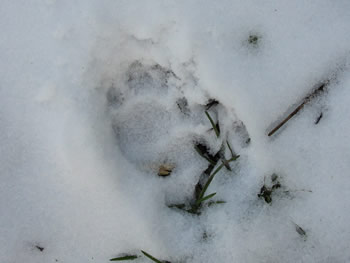
Recent big cat sensations in Gloucester
I must add something in regards to my friends Rick Minter and Frank Tunbridge in Gloucester and the DNA results of the two deer carcass remains.It is a shame that no positive results were found from big cats(so we are told) but that should not put people off or discredit the two in any way.If indeed no match was found then simply, the deer were not killed and eaten by cats as the DNA would have been there unless swabs were not taken correctly. It may be that the deer on this occasion had nothing to do with big cats but may have been killed by dogs and then scavenged by foxes, but certainly most of the deer remains found eaten in this region are certainly the work of big cats and it is a shame that this time, at such a good time with such media cover and commitment that no good result has come out of it.I myself ,do believe that the deer were killed and eaten by cats , but maybe the truth of the results cannot be revealed, a common practice regarding this type of testing.If the people doing the tests could only carry out the good work on other remains, then sooner or later the desired result will be obtained.There are many conspiracies to cover up the big cat truth and that is why many people are suspicious in regards to this kind of evidence finding.foxes do not hunt deer and cannot bring down adult roe deer, at the most they can only manage new born roe that are left by parents but it is rare as the kids do not smell, so to not attract predators, and they freeze when they see movement.such hype about foxes will only fuel peoples hatred for them and we know what happened in regards to the lies told about the London foxes that bit the baby !after climbing entering a house and climbing stairs. Rubbish! ! we now know that either designer cats or terrier dogs were involved.badgers are also not as predatory as people like to think and cannot bring down deer: they eat mainly earth worms.
the newspapers must learn to be more responsible when publishing articles, especially sensationalizing headlines regarding the hunting and feeding techniques of large cats. cats do not rip the throats out of deer or sheep and they do not tear apart deer but they quietly stalk, ambush, and deliver a swift bite and kill their prey quickly before cleanly eating them in typical cat fashion.If we want the general public to acknowledge the fact that large cats have been sharing our countryside with us for generations then we must tell the truth, and from all angles.no cover ups, no sensations,proper education and responsible news articles please.
A leopard caught on trigger camera ?
A question that so many people ask is `where are all the photos and video footage of big cats then? ‘ Well it is very difficult to photograph them in the wild, even when I have had sightings it has not been possible as they are so quick,weather may be foggy , or one can stand mesmerized by the moment.I have seen both puma and leopard over twenty times within my life and only once could I have taken a photo, but I had a silly Instamatic camera in my pocket, and I forgot that it was on my person.The best way to capture these animals is by trigger cameras but even they pose many problems. cats are very wary and they see the infra red light from a long distance off, or can even pick up the magnetic fields emitting from the device.Only by trial and error can one expect to come up trumps and even then the images may not be convincing to most people, such as the images below.In an area where I regularly find field evidence of leopards,I have placed infra red cameras for seven months with no success. The animals would hunt the sika deer and drink from a small sunken pond on the edge of a large area of heathland and natural woodland.I have at long last managed to take some from trigger camera,I briefly posted the pics here but removed them.For the time being I will not display it on this page as it will be used in a documentary.
Cat sightings and reports
06/04/11: One of the ways in which I suss out whether or not a large cat has been at a carcass is to look at the ribs and see if they have been bitten down close to the base by one strong sheering cut by its carnassial teeth.Here we can see the evidence.The power in the large jaws operated by large facial muscles along with very large cutting teeth cut cleanly through bone. A fox for example would have difficulty and it would not be a clean cut, and usually they look as though they have been gnawed rather than sliced through.
Over the last few weeks
I have come across several remains of deer that have been eaten by large cats.This roe buck was ambushed alongside a boggy area from gorse bushes along a regular game path.
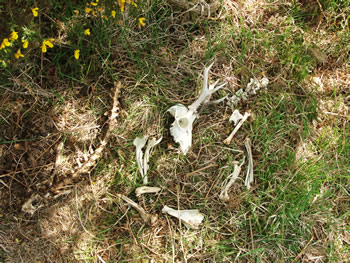
Also a sika hind was taken and was just a few meters away.I have found that good ambush sites are visited frequently and maybe deer are taken several times a year from the same spot. There must be many misses and the cat would have to try its luck at another favorable spot.
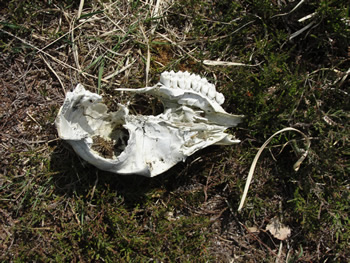
A sika deer was also taken and was just a few miles away.One can see quite clearly see how the strong carnassial teeth of a leopard can sheer through tough skull and limb bone.Most large cats feed in the same way but with small variations between individuals. There is variation in how every cat feeds in regards to which area it tackles first and if it takes out the rumen or not, or even if it eats the rumen or part of it.If the same style crops up time and time again then I can assume that it is most likely to be the same individual, and that knowledge is vital for serious research into where each individual hunts and as to how large a territory may be.
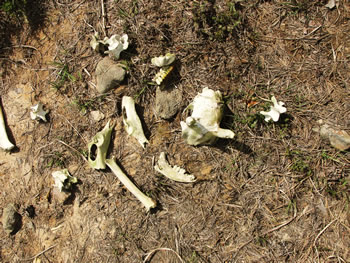
While on a zoology field meeting this week I came across the spoor of a female leopard, and near by the remains of another two sika deer, one was eaten under a lone pine, and the other was on top of a cliff under a gorse bush. there were also the remains of a fox.
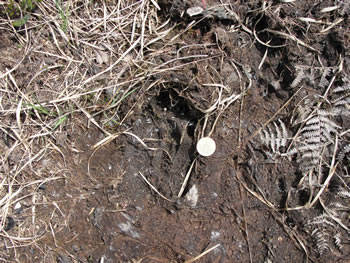
03/25/11
Link: http://www.thenaturalstuff.co.uk/
Lots of large scats have been found recently.During a new making of a documentary I have been busy looking for field signs.
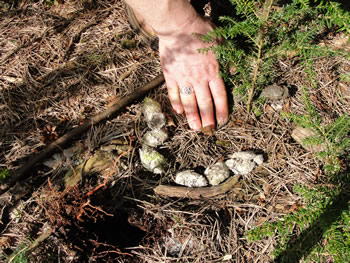
03/18/11
The past week has thrown up more evidence of large cat activity around my local areas.I have found three pug marks. one here which looks like a large male leopard.
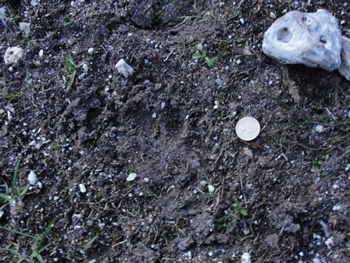
,
and two others, one of which looks like a cub.
this deer carcass was lying at the edge of water, a good ambush place where the leopard often hunts. It was just a few hundred yards from the spoor.
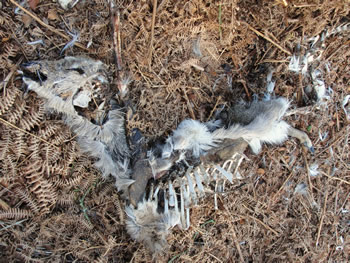
02/25/11
Link: http://www.thenaturalstuff.co.uk/
I hope to add a lot more content on the big cat blog site. I only put a small portion of my findings on here as I am keeping a lot of it to be published in my book, however, I have been bogged down with the sheer amount of data that I could not possibly put it all in a small book, so I have decided to add it to this site. watch this space!
02/25/11
Link: http://www.thenaturalstuff.co.uk/
Whilst helping a film maker in making a documentary on British big cats, we found a road carcass roe. I put it out of the way alongside a hedgerow behind a gate and suggested that I came back in a few days time to see whether or not a cat had eaten it. Here it is. It had certainly been dragged about forty feet away from the hedge and most of it has been eaten. I do believe that it was a cat and not foxes, badgers or dogs.
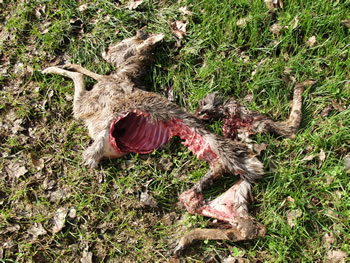
We also found a scat. This piece was found in an area where a large black cat had been seen by the maker of the documentary last summer, it was scavenging in his rubbish bag, hung from the wing mirror of his camper van. I dissected it and found the bones of a rat, of which were all broken. This is a sign that they had been chomped by jaws and not by a bird of prey because at first it looked like a buzzard pellet.
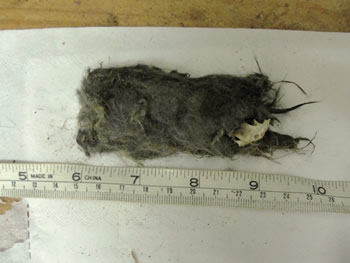
These two skulls were found during the same day as the two above subjects. One is a badger and the other is of a cat. Both have been predated.The canine tooth hole can be clearly seen on the cat in the foreground, and also on the snout part of the badger.
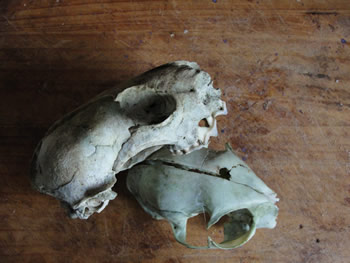
02/19/11
Link: http://www.thenaturalstuff.co.uk/
Just recently I have come across several scats in areas in which large cats frequent. I have collected them. I now have over fifty large scats of which possibly all of them are cat scats. I dry them out in the microwave oven first then let them dry again before bagging them up. I look at hair samples under the microscope and keep the ones that look like cat hairs. I then bag them up and date them .I have hundreds of hair samples, some of which have been positively identified as belonging to large cats. The proof is in the pudding. The irony of the fact is that much of the black hair I am finding is actually puma hair. Yes it would seem that there really are black pumas in the UK. Some of the very dark hair certainly does match that of leopard, and also some light coloured hair, even some annulated hair of which may suggest that we have normal coloured individuals also. I do not seem to find that much grey or brown puma looking hair lately. I certainly do have some in my collections’ also have some hair that are not puma or leopard but something else .I do not seem to find any evidence of golden cat or jungle cat or ocelot for example, It just seems to be puma/leopard orientated. There could also be hybrids of the two species. Some of the hair that I look at seems to be in between. There have also been several reports from Dorset over the last few weeks .I do believe that lynx numbers are on the rise, with over a dozen reports in one year.
02/12/11
Link: http://www.thenaturalstuff.co.uk/
These are the remains of a Roe deer that I found a few days ago. It had been stripped in a typical big cat style, again I think that the animal was firstly hit on the road by a vehicle before the cat scavenged it. There was also cat like hair on a near by barbed wire fence,and I have taken some to go with the many other samples that I have.
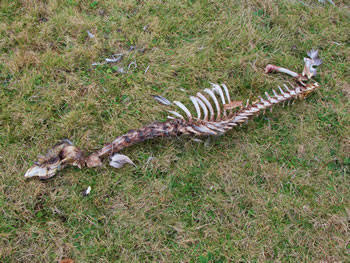
.
In this view,the scapula and the bottom jaw have large teeth holes in them, and the facial skin has been licked up.
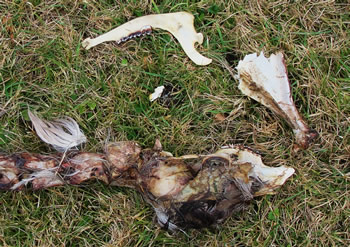
02/04/11
This ash tree had claw marks over seven feet high from the ground on a limb.I could see where the animal had jumped and tried to gain a foothold on the wet bow. Just away from the tree was a large scat containing deer hair .This was in the same area as the footprint.
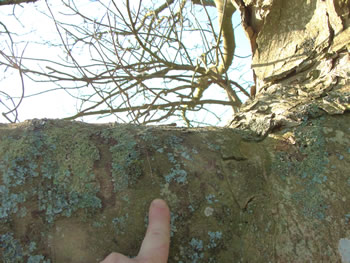
12/31/10
Link: http://www.thenaturalstuff.co.uk/
This is the latest spoor. My brother David took a phone photo of it and sent it to me today. It is from an area where many sightings have been and his lady friend saw one just a few months ago.There must have been many big cat footprints found during this cold snowy weather , all across the UK. I have been out a few times but have not managed to go far and so have not found anything lately.
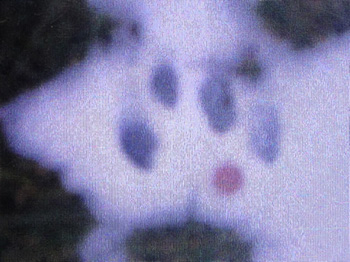
09/27/10
Link: http://www.thenaturalstuff.co.uk/
Local Sightings
During the last two weeks there have been three reported sightings; one of which was two years old of a black cat at Wimborne, two others of large black cats, one near Wareham and the other near Brockenhurst.
Link: http://www.thenaturalstuff.co.uk/
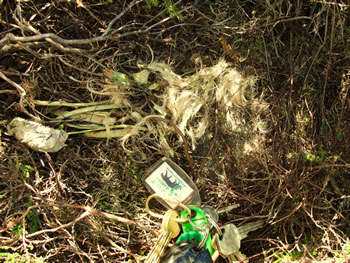
The latest cat scat I found in one of my study areas just shows how large some of the bone fragments can be. In this case whole ribs are present measuring up to 8cm in length. This was the remains of a new born roe kid or even unborn foetus.
09/05/10
Link: http://www.thenaturalstuff.co.uk

A recent trip to a few sites around Stroud and near Gloucester revealed as always signs of large cats. These areas are full of strange goings on regarding the phenomenon. Many eye witness reports and even photos and video footage of leopard and puma like animals. I try and visit at least once a year with friends and other big cat investigators in the area. A visit to a quarry revealed lots of smells and this typical leopard looking scat (below) and I retrieved the roe buck skull that was wedged in a tree last year.
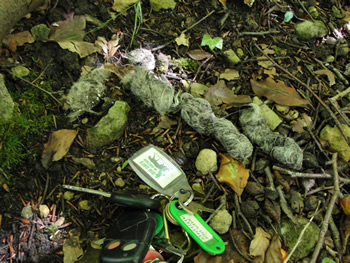
This roe kid (picture below) was at the end of a house driveway by the road in Slad. It did not show any signs of being hit by a vehicle, which would have been the most likely cause of death. It does show feeding by a possible big cat or a small big cat at least. The flesh is neatly removed and a whole front leg along with a piece of loin. Also an ear has been chewed off. A fox or dog would have opened up the rear and made a mess. The animal could have been carried before being neglected or, or maybe the cat killed it alongside the road and wasn’t hungry enough to complete or carry it away, or maybe it was being disturbed by early morning traffic or people.
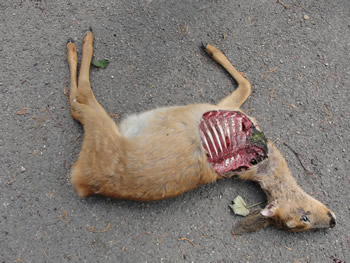
08/20/10
Link: http://www.thenaturalstuff.co.uk/
The beginning of August I found two sika deer carcasses that seem to have been eaten by large cats.
They were presumably road victims and then found by scavenging cats as they seem to here.
I have found nearly a dozen such cases before and they seem to be in the same areas.
There are many road casualties sadly along the roads in south Dorset especially around Purbeck, and maybe two or three deer are hit every week by uncaring motorists.
The large cats seem to know this and visit hotspot areas, places where the deer cross roads by habit.
One such road is right in the heart of leopard territory and in this case two sika were hit in one week and left as they usually are, on the roadside. The cats find them and may drag them onto the verge, but usually eat them where they fall even if that means in the middle of the road as there are no vehicles traveling at night on this particular road. The cats seem to gorge as much as possible before daybreak, then the day shift begins of busy lorries moving into the gravel and sand quarries.
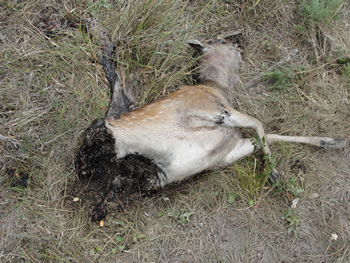
These two were hinds, one was a yearling.
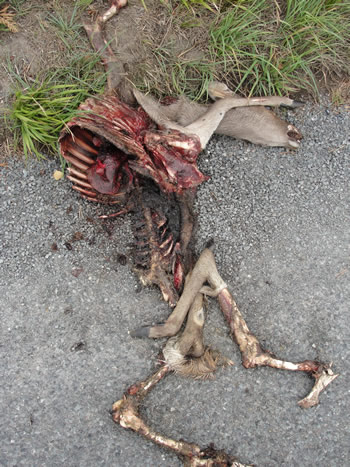
Other news.
I had a report of a large black cat at Bashley New forest last week, bigger than a domestic about three feet in body length.
There was also a sighting in west Dorset around the same time.
I am making a point of not putting all the sightings in that come to me for a couple of reasons. I do not want to attract attention to certain areas that have multiple sightings. There are many people who want photographs of these animals. There are also people who want these animals destroyed.
There are also people who want any information from people like myself to use it for other purposes. There rare too many sightings to log and it does not really mean much today.
There are special sightings in which people and animals are involved that have a special story attributed to it, but most sightings are brief glimpses just like thousands of others.
The Center for Fortean Zoology Conference 2010
Every year the CFZ hold a conference in north Devon. A large network of people are dedicated to investigating strange animals worldwide. We have a number of active people in the UK working on the big cat phenomenon . This year we had some good results as Danish zoologist Lars Thomas joined myself and others with a Danish science film crew and filmed events at the center and around the area. We were going to Dartmoor where I had several leads in regards to big cats. A puma was seen with cubs during the second week of August and a lynx during the same week just a few miles away from the puma sighting, also leopards have been seen around a steep valley many times.
We did not need to go as we just hopped out to the nearest large woods and got all the evidence we needed to prove that big cats were roaming north Devon. Myself and a few other colleagues’ collected many cat scats, complete with hair.
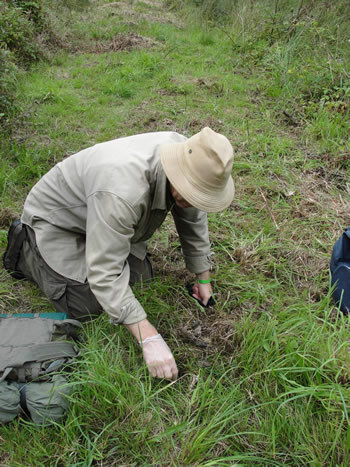
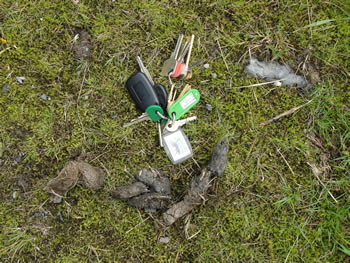
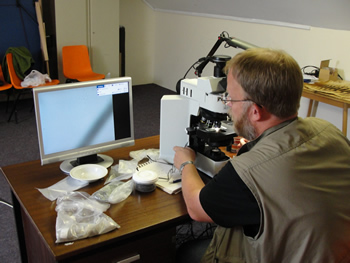
Lars analyzed them with an electron microscope in the lab and the verdict was leopard. He also looked at hairs from one of my many cat scats that I carry around in my display and confirmed my analysis of them being puma. These were from my study areas of Dorset. The same scat contained other cat hairs but were jet black. This may mean that we have black pumas, and I have looked at many hairs through my own microscopes and found very dark puma hairs.
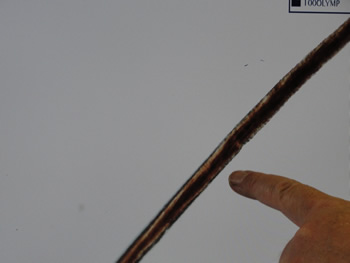
Lars, microscope and hairs
Clumps of black hairs collected from barbed wire also looks like puma hair as well as leopard and some looks like a cross between the two!. There certainly is something very odd about the species involved. I am sure that there are genuine leopards as well as pumas but it seems more possible that there are hybrids out there.
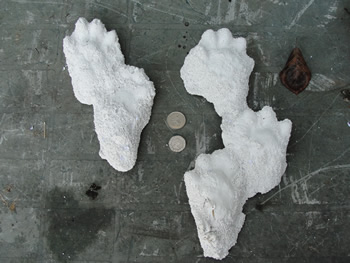
Also at the CFZ conference Oll Lewis an active member took the best examples of plaster casts of leopard tracks that I have seen , collected from snow last winter.
Other News.
It seems that there certainly is a conspiracy to hide the truth about big cats. There is so much evidence that has been collected, filmed, photographed and witnesses by police, army, other military, as well as the thousands of sightings by the general public including scientists. The authorities have suggested not to ‘let the cat out of the bag, ‘ in case of public fear or an outcry.
This could be possible, as most of the British public are very uneducated. They would fear for their own safety or for their children or pets. There would be anger and they would jump to conclusions and grab the gun. This is not the correct way to behave whether they be public, police or government body. The truth must be known about these animals and consultation from experts must be taken, not from DEFRA, or Natural England that are renown to be dishonest and incompetent. What is needed is a conference of all bodies and a good debate about it.
Then new legislation written up in regards to all animals concerned, the British public, fire arms conservation and then education. We cannot just sweep it under the carpet and hope it will go away. It will not. There are several species of cats involved, one of them native, most of them protected by law. Just because they are not in their native lands does or should not exclude them. There are too many to eradicate. But they are doing a good job at being the apex predator, keeping the populations of other smaller predators in check and most importantly keeping deer, hare and rabbit numbers down and healthy. We have been ranting on for years about the explosion in deer numbers, so now we have it, We have the natural control. Of course there will be many deer management groups that oppose to this as they think their jobs are at stake. Get real !!.
07/16/10
Link: http://www.thenaturalstuff.co.uk
This tiny dung beetle uses carnivore dung for its offspring to feed and large cat scats contain just the right ingredients for this species. I commonly find them in cat scats.
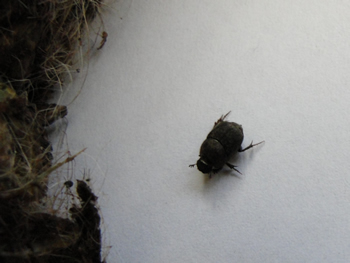
05/07/10
Recent Cat Signs
Link: http://www.thenaturalstuff.co.uk/
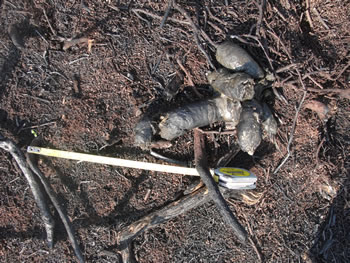
This scat was found on a recent burned piece of heath on Purbeck in an area frequented by large cats. It has all the hallmarks. It would seem that cats are attracted to burned areas of land. I collected this one as I do with at least half the possible cat scats that I find. It contained rabbit hair and bones.
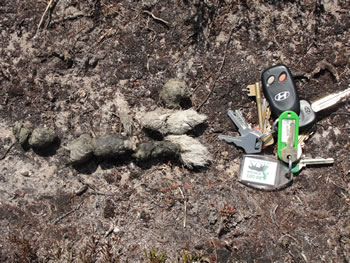
This scat was found while on a zoology field meeting to observe reptiles and look for bag cat field signs also in Purbeck. I was taking a small party through a heathland track where there are often scats and one member found them on the edge of the path. The scat contained deer hair and duck feathers.

This is an otter skull found by myself on the heath where often I find remains of deer eaten by large cats. It was away from water, although this in itself does not mean much but it was under a bush without the rest of its bones. It may have been taken by a cat, or moved by a fox from its original dying place.
There have been many reports of big cats in my region over the last two months. On average I get several a month. Most crop up from the same places, but are seen by differing people. Most are big and black, identified as leopard by most observers. Although I do believe the number of cats in my study areas have dropped as I am not finding as many field signs as I was a few years ago. I do fear that some are being killed. There is plenty of prey around although the deer numbers in some areas are starting to fall due to poaching. It is rife here in south Dorset. The authorities seem to turn a blind eye to it.I am always finding the cut of feet of deer thrown away in lay-byes or on heathland, a typical sign of poaching. Many small herds have gone from cat territories. If this continues then cats may be forced to take livestock. Last week a rhea farmer at Winfrith had some rheas killed and she thought that they were killed by cats, very possible. I have not as yet spoken to the lady or seen the remains but a colleague said that the carcass went. What I found very disturbing was the reply to the newspaper feature on it in the Echo. Some people are still very adamant that big cats do not exist here and make very rude remarks in the comment system. It is very saddening.
Another sad note is the fact that the yearly big cat conference has been cancelled this time round. I have been told that it was due to a double booking and also because of lack of support.I am thinking of holding one in Dorset or even starting a new group here. If any one is interested please let me know.
This scat I found on Studland Heath in a place where I often find scats. I have come to realize that cats are creatures of habit and some areas have been used for over six years.
03/26/10
The Wild Cat
Link: http://www.thenaturalstuff.co.uk/
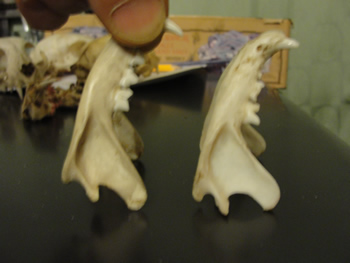
These are the bottom jaws of domestic cat (left) and wildcat (right)note that the wildcat jaw stands upright when placed on its back axis.This is to do with the positioning of the hinge in relation to the curvature of the jaw itself enabling it to balance.The domestic cat dimensions are different in the mature animal and so the jaw will not balance.There are many other small differences with both species.
This looks like a wildcat kitten felis Sylvester. After taking its jaw out (The left side bottom) was the only intact piece, There were similarities with the wild cat jaw, but more so with the jaw of the domestic cat. It looked in between if any thing, yet it was a juvenile and its bone structure and teeth were not fully formed. Its canine tooth was not even above the bone, but deep within its socket. I presume it was its adult tooth just coming through. The bone was also short in comparison with two other full jaw bones, one of a domestic cat, the other of a wild cat. There are several small yet noticeable differences when the two species are viewed together.
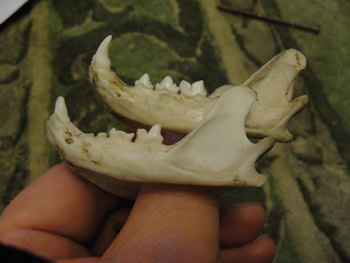
Below are the three jaws together:-
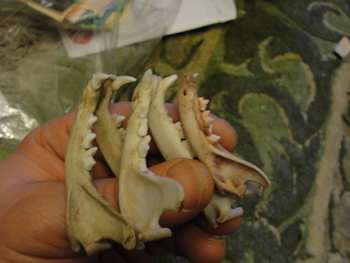
The kitten jaw looked like an in between and had three of the five differences toward the wild cat, one of the two similarities with domestic, was the fact that the jaw would not have balanced and stood upright if placed on its hinges like a wildcat. I so concluded that it was a hybrid , or that if the jaw grew longer then the three pieces of bone responsible for balancing it would have extended enough to balance it when fully formed.
Below is the jaw of the kitten, note its canine tooth has not erupted from the cavity.
In this case it may not have been a hybrid , but due to the fact that there are many feral domestic cats here and very few if any wildcats, the chances of it being pure are very slim, even if it had originated from released wild cat parents. In Scotland most wildcats are tainted with domestic genes. It has all the other characteristics of being a wildcat and its fur is very dense and deep. Also its hind feet are slightly larger and broader than its fore feet. A characteristic I believe to be of the wildcat. There is no white on it, the underside of its feet are black and its pads, with thick hair between. Its tail is thicker than any cat I have seen especially at the base. It slightly tapers but this is normal for a kitten wildcat. It is also short, with the right amount of rings rather than broad angular bars like a domestic. It is very stocky with thick legs. It’s ears seem to be positioned further apart also. They have the right colouration on the backs.
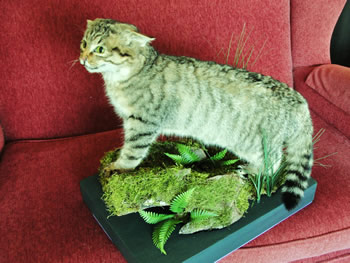
This is the finished mounted specimen.
There have been rumours about wildcats still living in south west England, especially between the world war years. I did not doubt them. I even saw a possible wild cat in Mid-Dorset about ten years ago in an area where other reports have been. This was in the Cranborne Chase area. Now I have found the road kill body of what looks like one such individual from that very area. It is a kitten ,possibly a late birth. Maybe the mother had lost her first kits and came into season immediately afterward so had a late litter, the kitten leaving its mother only a few weeks ago perhaps.
03/13/10
European Wild Cat In Dorset
Link: http://www.thenaturalstuff.co.uk/
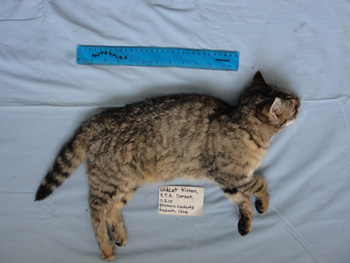
This is the body of a road killed wild cat felis sylvestris. Found by myself just a few days ago.There were old unconfirmed records of this species living in southern England in the counties of Somerset, Dorset and Wiltshire between the two world wars. I do not doubt them. I have even had a sighting of an animal in Cranborne chase many years ago and this road kill specimen was from the same place. It has all the hallmarks of being the genuine article. It was only a kitten and so small yet with the characteristics of the markings and tail length , also the ears are set wide apart. This is how I found the animal.
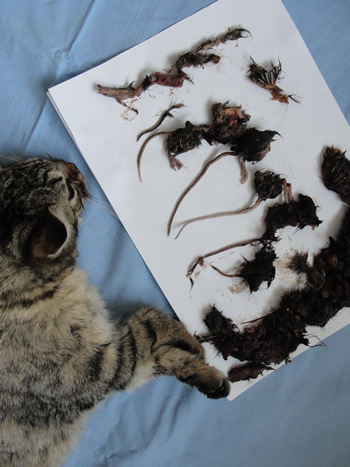
This is the contents of the animals stomach. Six rodents including three wood mice, one yellow necked mouse, one rat , a short tailed vole and the remains of a redwing thrush.
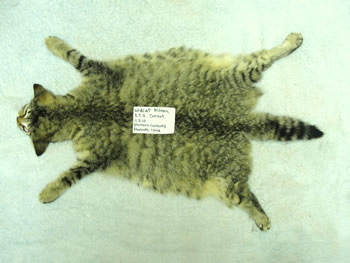
This is the skin afterward. Flesh and hair have been saved for genetic analysis.
03/06/10
Fox and Cat Remains
Link: http://www.thenaturalstuff.co.uk/
This road kill roe doe was partly eaten by a fox. Please compare with examples eaten by cats. Note how messy the removal of the haunch is and the small amount of flesh taken. This has probably been three separate visits. This carcass has now been moved to my camera site in its current state except for the removal of the back meat (loin) of which was my own action.
This is a large fox scat for comparison with the cat scats. Note it has been eating tiny crustaceans.
This is a typical cat scat. Note that it is made up sika deer hair.
This is a typical cat scat found in one of my study areas. Hairs from it were analysed and matched as being leopard.
02/19/10
Big Cat Evidence in the Derbyshire Dales
Link: http://www.thenaturalstuff.co.uk/
I found this carnivore scat in Derbyshire at a place called Crowdecote, near Harpur Hill (photograph below). It looked like a cat scat, but rather small. It was broken up and a few paces away I found other parts to it that had been broken off by the feet of many human walkers, still it was not complete. It contained only badger hair. The scat was deposited by a wall in a sheep field, date 17th February 2010. I was in the area only for three days and it was the only large cat evidence I came across.
12/31/09
Big Cat Talk
Link: http://www.thenaturalstuff.co.uk/
I am giving a talk on The big Cat Phenomenon update on the Wednesday 20 January.at the Bournemouth Natural Science Society at 2.30 pm. I give at least two updates a year and are mainly incorporating my local findings and sightings by other people. All are welcome, none members may donate a small fee.
12/05/09
Not a big cat
Link: http://www.thenaturalstuff.co.uk/
Not a big cat, but a large domestic cat was found as a road victim by me near Ringwood two days ago. If this animal was seen prowling around, it is easy to see why some people may mistake it for one, but of course it is only small, with a body size of just thirty inches and a tail of fifteen.
11/27/09
Trigger Camera Pictures
Link: http://www.thenaturalstuff.co.uk/
My trigger camera that is out on heathland still has not picked up any cats, but I believe a cat was in front of it eating the carcass of a sika deer that I bated it with just a week ago. Some animal jogged the camera and loosened the batteries out of their holds and it stopped working just as a cat started to feed. Is this sod’s law or what?
The second carcass was a small roe doe and was partly eaten by raven and buzzard the day after. I am confident that I will soon manage to shoot the cat in this area. It seems to visit the area around every ten days. Although at least three species have been described in the immediate vicinity.
Note the lung that has been taken out by the raven and placed on top of body.
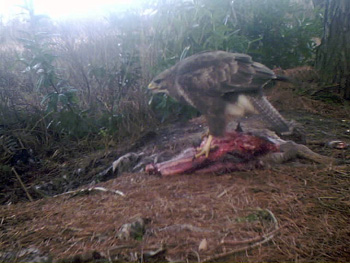
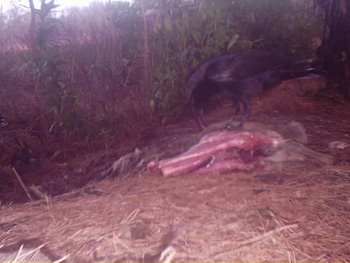

11/13/09
Swan remains at Keyhaven Marshes near Lymington
Link: http://www.thenaturalstuff.co.uk/index.html
These swan remains were found at Keyhaven marshes near Lymington, Hants. There were no other remains except for lots of plucked feathers and a radius and ulnar. There was a scat near by. Also there were the remains of a Canada goose approximately a quarter of a mile away. It was eaten in a typical large cat fashion.
10/30/09
Recent cat activity
Link: http://www.thenaturalstuff.co.uk/
This cat scat was found at Arne nature reserve on one of my BNSS field meetings to watch rutting sika deer and to look for big cat signs as this place is always buzzing with activity. This scat was found by a member. It was half buried and one can see where the cat scraped with its paws(possibly hind) to bury it. This is leopard behavior and we are constantly finding evidence of this species here.A smooth dor beetle was at the scene and was dead. It too had laid its eggs and buried a small piece of the scat. Later after micro waving the scat and cleaning it I re-assembled it and looked at the contents of which were pheasant remains and some cat hairs, looking like leopard.
This sat was found by member Steve. It was near to the first one but contained rabbit fur. I as yet have not found any cat hair within it, but will try at a later date.It was not buried, but in the open and dry. It was approx two weeks older that the first scat.
10/30/09
Link: http://www.thenaturalstuff.co.uk/
This is the two scats re-assembled clearly showing the pheasant bones and rabbit fur.
Derbyshire
Link: http://www.thenaturalstuff.co.uk/
On a recent trip to the Derbyshire Peak District, I kept my eye open for signs of big cat activity.Some possible evidence, I found many remains of sheep skeletons in certain woods and among heather near craggy tors.It is a typical area of which one would expect to find some evidence, but I did not have too long time to investigate.
10/03/09
Cat scat near by
10/03/09
More of the cat scavenged deer carcass
10/02/09
Scavenged Deer Carcass
This sika deer carcass was originally hit by a vehicle during the night. Then a big cat started to feed from the rear end.It liked the skin in cat like fashion tripping off the hairs.It took about seven pounds of flesh in weight before taking off the skin around the rib cage as they often do.It carefully avoided the stomach.
08/19/09
During my annual visit to the weird weekend (cryptozoology conference) in North Devon, a few people went off into the North Devon country side and found a variety of objects that could be related to the big cat phenomenon. some remains of a roe deer and a front leg from a domestic dog were found along with several scats and some hair. The hair has yet to be analyzed and another batch of hair that was passed to Lars from a farmer is to be analyzed . I collected a cat scat myself from near Clovely and i believe the other stuff came from nearby. A campsite owner claims that she had to move the campers into another field because she claims that a lion and its cub were walking through that particular field.The lion was apparently black!. all this happened during the weekend of the 15-17 August.
07/06/09
There have been a lot of reports lately.More than average for June.most sightings occur during the winter months with a drop as summer comes, but there have been double the usual amount of big black cat sightings for mid summer onwards.Gloucester has had a few, and i myself spent a few days with Rick minter and Chris Johnston in Gloucester near Stroud, and the forest of dean. At Woodchester area, thistledown event of big cat talks to family groups was well attended with wildlife walks afterwards. We were given several reports by attendees from around the area.We spent some time in one of the many quarries around the Stroud area and in one I found a roe buck wedged in a low tree. it had been consumed with just antlered head and spine left. I got the idea that the buck was not trying to mark the tree and accidentally got stuck(this can happen)but was forced into it by a large predator such as a large cat. photos will appear soon. I would be most interested to receive your comments.In the same quarry we smelt cat sprays on rocks and trees . it is an area where there has been several sightings recently.
05/30/09
Have you any news ?
Have you had an experience you would like to share?
Have you seen a large cat?
Do you know of any one else who has something to report?
Please feel free to report it here.
Any comments on the above report?
05/28/09
Big Cat Sighting at Stoborough (near Wareham, Dorset) 15th May 2009
Marc Eldridge and James Leaver both of whom live at Stoborough near Wareham (Dorset) spotted an animal they describe as being a lynx on the heath near their home on the 15th May 2009. It was dusk. They saw it for some time as it tried to hide in the heather as it moved away from them. They describes it as being very large and brownish with spotting on its rear with no apparent tail.They first saw it from the car as they were driving near Corfe castle. it crossed the road in front of them, and James first saw it . They both got out of the car and followed it for several hundred yards and got several glimpses of it. It stood at least two feet high above the heather He also claims that a witness had seen a black panther cross the road at the Springfield Hotel just on the other side of the village.
Marc also claims that he has had two other reports during the last week of black leopards in the same area.

